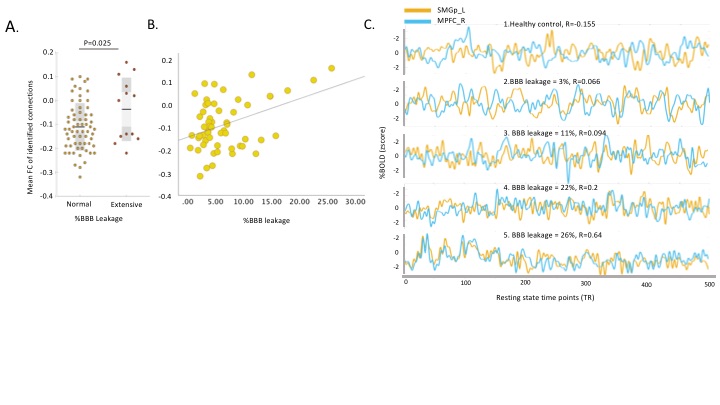Session Information
Date: Saturday, November 6, 2021
Title: Plenary I (0453–0457)
Session Type: Plenary Session
Session Time: 11:30AM-11:45AM
Background/Purpose: Cognitive impairment is the most frequent manifestation of neuropsychiatric systemic lupus erythematosus (NPSLE), yet the mechanisms underlying it remain poorly understood. We have previously reported an association between enhanced permeability of the blood-brain barrier (BBB), loss of grey matter volume and cognitive impairment in SLE patients. To further explore these associations and identify pathogenetic mechanisms the current study examined non-task based functional connectivity between brain regions using resting state functional magnetic resonance imaging (rsfMRI).
Methods: Adult patients with SLE (n=78, age 49.4 ± 14.3 years, 89.7% female) and healthy controls (n=71, age 38.9 ± 12.9 years, 69.0% female) were recruited at a single academic medical center. To identify cognitive impairment (CI) in SLE patients, global cognitive function and performance in five individual cognitive domains were assessed using standard neuropsychological tests. Quantitative assessment of BBB permeability was measured in SLE patients by dynamic contrast-enhanced magnetic resonance imaging (DCE-MRI). All study participants underwent rsfMRI, in which blood oxygen level dependent (BOLD) signals were collected as a proxy for neural activation. Mean BOLD signals were extracted from 131 regions across five canonical resting-state brain networks to analyze the resting-state functional connectivity (rsFC) between brain regions. The rsFC values were then compared between healthy controls, SLE patients with and without CI and between SLE patients with and without extensive BBB permeability.
Results: Fifty-one connections between functional brain regions were found to differ between SLE patients with CI and those without CI (P< 0.05, FDR corrected). Multivariate analysis of variance demonstrated differences between SLE patients with CI and healthy controls (P=0.006) (Figure 1A & 1C). In SLE patients with CI, within-network connectivity was significantly different for the sensory, attention/executive, and language memory networks (Figure 1B). The between-network connectivity differences occurred primarily between the sensory and attention/executive networks and between the default-mode and language-memory networks (Figure 1B). Mean functional connectivity of affected regions was different between SLE patients with normal BBB permeability and SLE patients with extensive BBB leakage (P=0.025) (Figure 2A & 2B). SLE patients with CI (Figure 1C) and those with extensive BBB leakage (Figure 2) had more positive functional connections compared to the other groups. Finally, the total number of brain-wide connections of specific brain regions decreased with higher BBB permeability (P=0.011) and was lower in SLE patients with CI than in SLE patients without CI (P=0.01, Figure 3).
Conclusion: SLE patients with CI demonstrated distinct differences in brain functional connectivity relative to SLE patients without CI and healthy controls. Within the SLE sample, these functional connectivity differences were also seen in those with extensive BBB leakage, suggesting an association between BBB leakage and neural pathology underlying CI in SLE patients.
To cite this abstract in AMA style:
Hanly J, Robertson J, Kamintsky L, Friedman A, Beyea S, Fisk J, Omisade A, Calkin C, Bardouille T, Bowen C, Legge A, Mitnitski A, Matheson K, Hashmi J. Functional Connectivity, Enhanced Blood-Brain Barrier Leakage and Cognitive Impairment in Systemic Lupus Erythematosus [abstract]. Arthritis Rheumatol. 2021; 73 (suppl 9). https://acrabstracts.org/abstract/functional-connectivity-enhanced-blood-brain-barrier-leakage-and-cognitive-impairment-in-systemic-lupus-erythematosus/. Accessed .« Back to ACR Convergence 2021
ACR Meeting Abstracts - https://acrabstracts.org/abstract/functional-connectivity-enhanced-blood-brain-barrier-leakage-and-cognitive-impairment-in-systemic-lupus-erythematosus/



